The History of Monkey Island
Charting the evolution of an adventure classic

After thirteen years, it is once again time to set sail to Monkey Island, with the sixth entry in the legendary comedic point-and-click adventure series, Return to Monkey Island, arriving on September 19th. Before returning to Monkey Island™, let’s have a look back at the entire Guybrush Threepwood saga.
LucasArts and the age of adventure games
Once upon a time, point-and-click adventure games ruled the PC gaming landscape (that time was about 1984 to 1993). The two giants of the genre were Sierra Online, developers of King’s Quest, Space Quest and more, and LucasArts. Founded in 1982 by George Lucas under the name LucasArts Games (as a companion to his film production company), LucasArts became a prominent player in the games industry with its combination of licensed Star Wars games and point-and-click adventures created with its famous SCUMM engine. The SCUMM engine was created by Ron Gilbert for his 1987 classic, Maniac Mansion (SCUMM stands for Script Creation Utility for Maniac Mansion). With its verb-laden interface, puzzle-heavy gameplay, and focus on humour, Maniac Mansion set the template for LucasArts’ adventure game success. LucasArts released eleven further games in the SCUMM engine in the following ten years, many of them considered classics of the genre, such as Day of the Tentacle, Sam and Max Hit the Road, Full Throttle, and of course, the Monkey Island series.

The Secret of Monkey Island (1990)
Maniac Mansion was the first step towards Ron Gilbert’s ideal for the adventure game genre. Gilbert didn’t like the harsh penalties that Sierra's games dished out to players who took a wrong step, among other things. In fact, the man who goes by the online moniker ‘The Grumpy Gamer’ wrote an article in 1989 called Why Adventure Games Suck, which outlines what Gilbert found frustrating about adventure games and doubles as his, and subsequently LucasArts’, design ethos - no dying, no unwinnable game states, and no text parsers.
Gilbert was inspired by Tim Powers’ pirate fantasy novel On Stranger Tides and Disney World’s Pirates of the Caribbean ride when he pitched The Secret of Monkey Island. Once he got the go-ahead, he picked out Tim Schafer and David Grossman, who were just starting out in the industry, to co-write the game and help with the programming. This trio only worked on The Secret of Monkey Island and its sequel, but each of them would be instrumental in shaping the adventure game for decades to come.

I’m Guybrush Threepwood, Mighty Pirate
The series protagonist (the ridiculously named Guybrush Threepwood) doesn’t know a thing about pirating at the beginning of Monkey Island. This was a conscious choice by Ron Gilbert, so that players could be introduced to the game’s pirate-centric world at the same time as the protagonist. The blonde, clean-cut Guybrush stands out from the more classically rough-and-tumble pirates, which belies his inexperience. This doesn’t mean he’s lacking confidence, even though his only discernible skill is that he can hold his breath underwater for ten minutes (a fact used in one of Monkey Island’s most famous puzzles). To begin with, Guybrush has to complete the three trials to officially become a pirate on Melee Island – find buried treasure, steal an idol from the governor’s mansion, and defeat the Sword Master. As you complete these trials, you will meet the many of the characters that became series staples, such as the pirate governor and love interest Elaine Marley, the unnamed but always helpful voodoo lady, overly animated used ship salesman Stan, and of course his nemesis, the ghost pirate LeChuck.
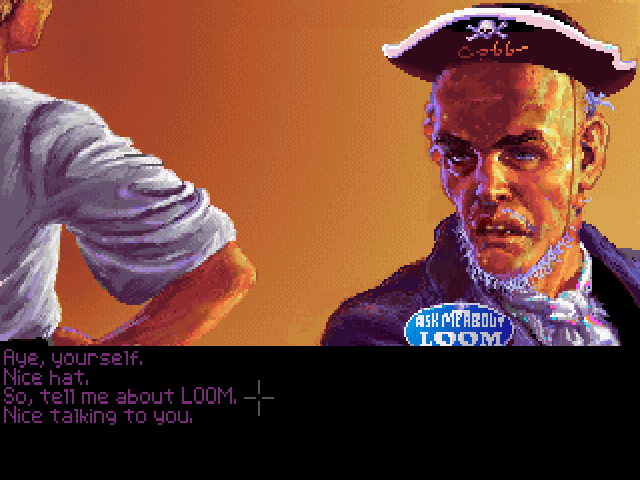
How appropriate. You fight like a cow.
The Monkey Island series is full of classic gags that break the fourth wall, as well as jokes that poke fun at genre conventions – both in adventure games and pirate stories. Some of the best loved jokes include a character from Loom, the musical LucasArts adventure game that was released the same year as Monkey Island, brazenly spruiking his game, and a faux Sierra style game over screen. There’s also a rich vein of running jokes, such as the liberal use of the ™ symbol. But the most famous and enduring bit of humour from The Secret of Monkey Island is the insult sword fighting. With Monkey Island putting all of its gameplay focus on puzzle solving, the insult sword fighting is a clever way to have classic pirate swashbuckling in a combat-free game. For those unfamiliar, to win an insult sword fight you must match your opponent's insult with a suitable comeback, then hit back with your own insult that you’ve picked up from previous fights.
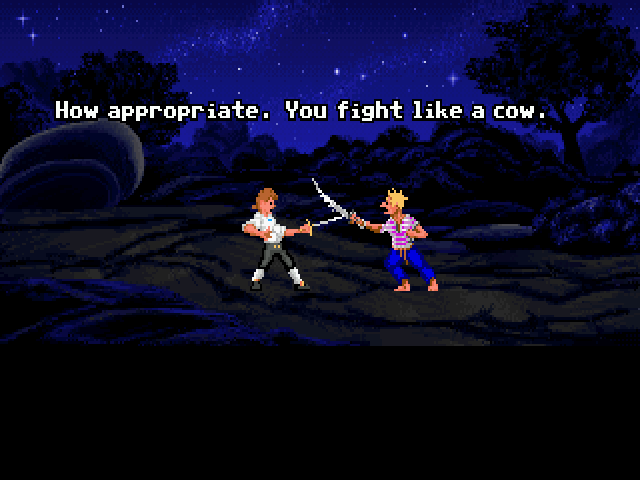
That’s the second biggest monkey head I’ve ever seen!
Following the three successful trials, Guybrush embarks on what will become a familiar quest – he has to find a ship and a crew so he can explore the tri-island area in search of the mythical Monkey Island and a way to rescue Elaine from the clutches of LeChuck, who is set on marrying the governor. At its heart, it’s a damsel in distress story. But Elaine’s character (a governor who is very much still a pirate), and the chemistry between her and Guybrush, elevates her well above the Princess Peaches of the world.

Monkey Island 2: LeChuck's Revenge (1991)
Shortly after the release of The Secret of Monkey Island, Gilbert, Schafer, and Grossman got to work on a sequel. They built on concepts that had to be left out of the original, and created a more open-ended game while still sticking to Gilbert’s adventure game principles. The team were looking to expand on the modest commercial success of Monkey Island, and even went as far as including a shorter, easier version of LeChuck’s Revenge to try and bring in a new audience.

You do turn up in the strangest places
LeChuck’s Revenge is a story told in flashbacks, as you start the game seeing Guybrush hanging by a literal thread, one hand clutching a large treasure chest. Elaine makes her way down a rope and asks Guybrush to explain himself. Guybrush, who was dumped by Elaine between games, was on the hunt for the legendary treasure known as Big Whoop on Scabb Island. The island is terrorised by LeChuck’s former first mate, Largo LeGrande, and gets in between Guybrush and the open sea. Guybrush tries to take care of Largo with the help of a voodoo doll, but only succeeds in helping him resurrect LeChuck as a zombie.

I'm sensing a disturbance in the Force
The open-ended section of LeChuck’s Revenge involves Guybrush seeking out the four sections of the map that will reveal the location of Big Whoop, which is rumoured to contain the secret to travelling to another world – very handy if there’s a vengeful zombie pirate on your tail. Guybrush enlists the help of both new characters, such as cartographer and frequent source of bad fortune Wally, and returning ones such as Stan, who is now in the used coffin business. Along the way, Guybrush will compete in grog drinking and spitting contests, outwit the law, rig some gambling, and navigate tricky mazes (another series staple). All with the same level of wit as the original, plus a liberal sprinkling of Star Wars references.

The end?
Spoilers for a 31-year-old game, but LeChuck’s Revenge has a twist ending that proved to be divisive. During the final confrontation between Guybrush and LeChuck, it’s revealed that this has all been a game of make-believe between two brothers in a pirate theme park. Then it shows Elaine saying that Guybrush may be under a spell cast by LeChuck. This ending, which was designed to completely mess with players’ expectations of a game’s finale, certainly achieved its goal, though it was not exactly popular.

LeChuck’s Revenge was a critical success like its predecessor, but a commercial disappointment. It is also the last time Gilbert, Schafer, and Grossman worked on a game together. Gilbert left LucasArts shortly after to found Humongous Entertainment with fellow employee Shelley Day, and made a string of well-loved adventure game series for children, such as Putt-Putt and Freddi Fish. Schafer and Grossman worked together on Day of the Tentacle before the latter left to go freelance. Schafer stayed at LucasArts, leading the teams behind Full Throttle and Grim Fandango before founding Double Fine.

The Curse of Monkey Island (1997)
A lot changed in the world of PC gaming between the releases of LeChuck’s Revenge and The Curse of Monkey Island in 1997. Huge leaps in technology meant that not only did adventure games look and sound different, but LucasArts had bigger, bloodier competition than Sierra – the wave of FPS games led by id’s DOOM and Quake. This was the scenario that the new Monkey Island team, led by Jonathan Ackley and Larry Ahern, found themselves in when creating LucasArts’ final game made with the SCUMM engine. The version of SCUMM that’s used in Curse is the result of refinement from the games developed between Monkey Island entries, so gone are the word selections at the bottom of the screen, and included is full voice acting and an eye-catching hand-painted style. Like LeChuck’s Revenge, Curse has two difficulties - a regular mode and one with extra puzzles.

She’s not going to be happy about this
The Curse of Monkey Island begins with an escape from LeChuck’s ship, a marriage proposal, and more or less a complete rejection of the twist ending in LeChuck’s Revenge. It turns out the diamond ring Guybrush nicked from Lechuck’s ship had a curse on it, Elaine turns to a gold statue when she puts it on. Then she gets stolen, because Guybrush left a gold statue unattended on a pirate island. What follows is the now-established Monkey Island formula – find a crew, find a ship, explore a set of islands, and rescue Elaine from LeChuck and other villains. Along the way, there are returning characters, such as the long-suffering Wally and Stan, who are selling life insurance after being locked in a coffin by Guybrush in the previous game. There’s also a twist on the first game’s insult sword fighting, which is now preceded by a naval battle.
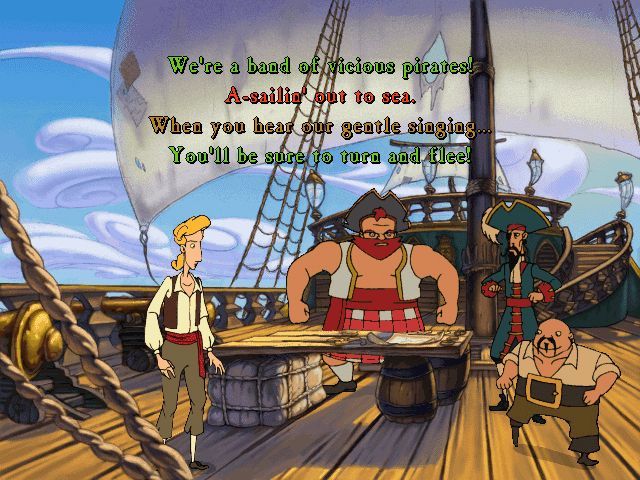
I am a powerful demonic force! I am the harbinger of your doom!
The Curse of Monkey Island, while not held in quite as high esteem as the previous entries, still has plenty of quality gags, including some fun fourth wall breaking puzzles. Many of the best lines are attributed to a new character, Murray the demonic talking skull. He is a constant voice of impotent rage, as he talks up a big game to Guybrush, but has no means to follow through, on account of being just a skull, small enough to fit in Guybrush’s inventory. He manages to find his way to Guybrush throughout the game, which ends with LeChuck using Big Whoop to trap Guybrush in a (literally) hellish amusement park.
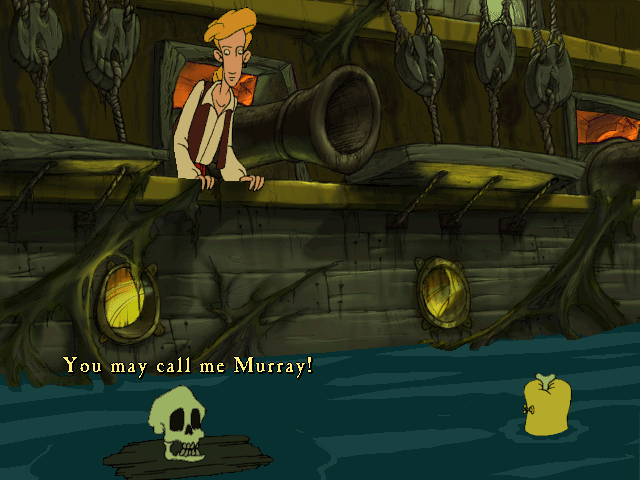
Curse marked the end of an era of sorts, with LucasArts moving to 3D in future adventure games to try and keep up with the times. The game sold particularly well in Germany, which proved to be a sign of things to come. Many say the point and click adventure genre died, but it never stopped being popular in Europe.

Escape From Monkey Island (2000)
With another new team and a new engine (the GrimE engine used previously with Tim Schafer’s Grim Fandango), LucasArts looked to move Monkey Island to the third dimension with Escape from Monkey Island.
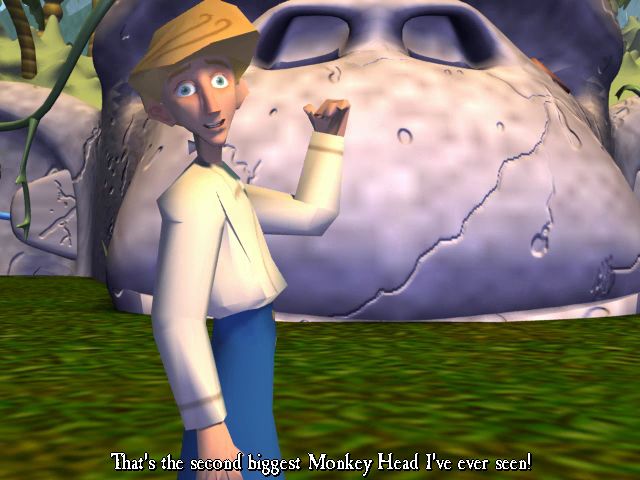
'Twas the marriage that kilt her, they say
The game begins with Elaine and Guybrush returning to Melee Island from their honeymoon, only to find out that Elaine has been declared dead and has therefore been removed as governor. To make matters worse, there’s someone gunning for her spot: the mysterious Charles L Charles, and an Australian business tycoon named Ozzie Mandrill, are trying to buy up everything in the tri-island area. It turns out that Mandrill and Charles, who is actually the now demonic LeChuck, are in cahoots and looking to put together the pieces of the Marley family’s secret treasure – the ultimate insult. This is not just an insult, but a voodoo talisman that can bring down every pirate in the Caribbean.

Are you ready for…Monkey Kombat?
Despite the move to 3D, the formula of Monkey Island is largely intact for Escape, with one large exception. The insult sword fighting makes way for Monkey Kombat, a Mortal Kombat parody that involves countering moves made by opposition monkeys by using a series of ooks, eeks, and acks. It’s essentially one very big puzzle that is randomised for each game, meaning ever reliable guides are out of the question, and proved to be a divisive element of the game. There are plenty of twists and turns in the game, along with the series’ trademark humour, but whether you enjoy Escape boils largely down to how much you enjoy Monkey Kombat.
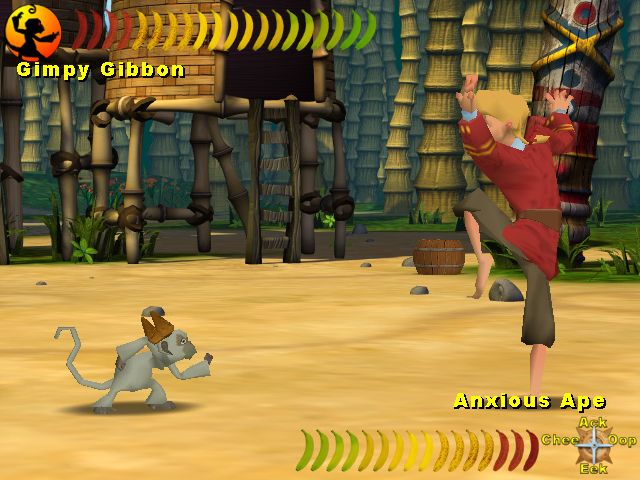
No, that’s not true, that’s impossible
Curse marked the end for the legendary SCUMM engine, but Escape marked the end of the LucasArts adventure game. Despite doing well in Europe, LucasArts decided to focus on developing Star Wars games, cancelling sequels to Sam and Max and Full Throttle in the process. Aside from remasters of the original two Monkey Island games and a handful of 3rd person shooters, LucasArts stuck to that MO till they shut shortly after LucasFilm was bought by Disney in 2012. Thankfully, some former LucasArts employees formed a new studio that aimed to continue the spirit of those SCUMM engine classics.
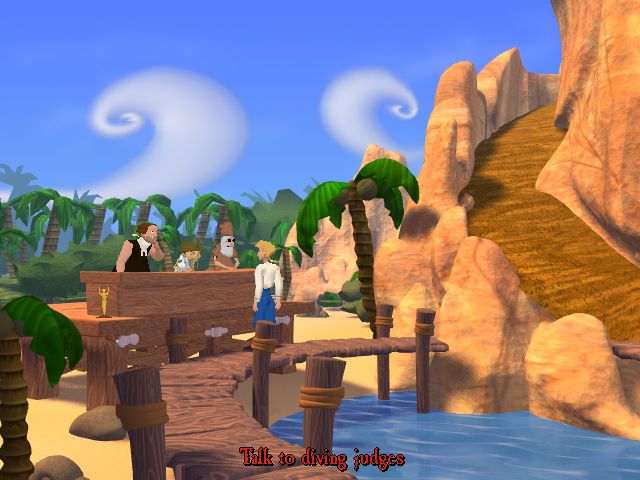
Tales of Monkey Island (2009)
Telltale Games was founded in 2004 by former LucasArts devs Kevin Bruner, Dan Connors and Troy Molander. Their aim was to continue making the kind of adventure games they made at LucasArts, but with even more of a focus on storytelling and a unique episodic structure. While Telltale became best known for their branching narrative games such as The Walking Dead, they began by developing paint and click adventure games based on existing IPs, most notably former LucasArts properties Sam and Max and Monkey Island. For these two series, Telltale brought on David Grossman, marking a long-awaited return to Monkey Island for one of the original leads.
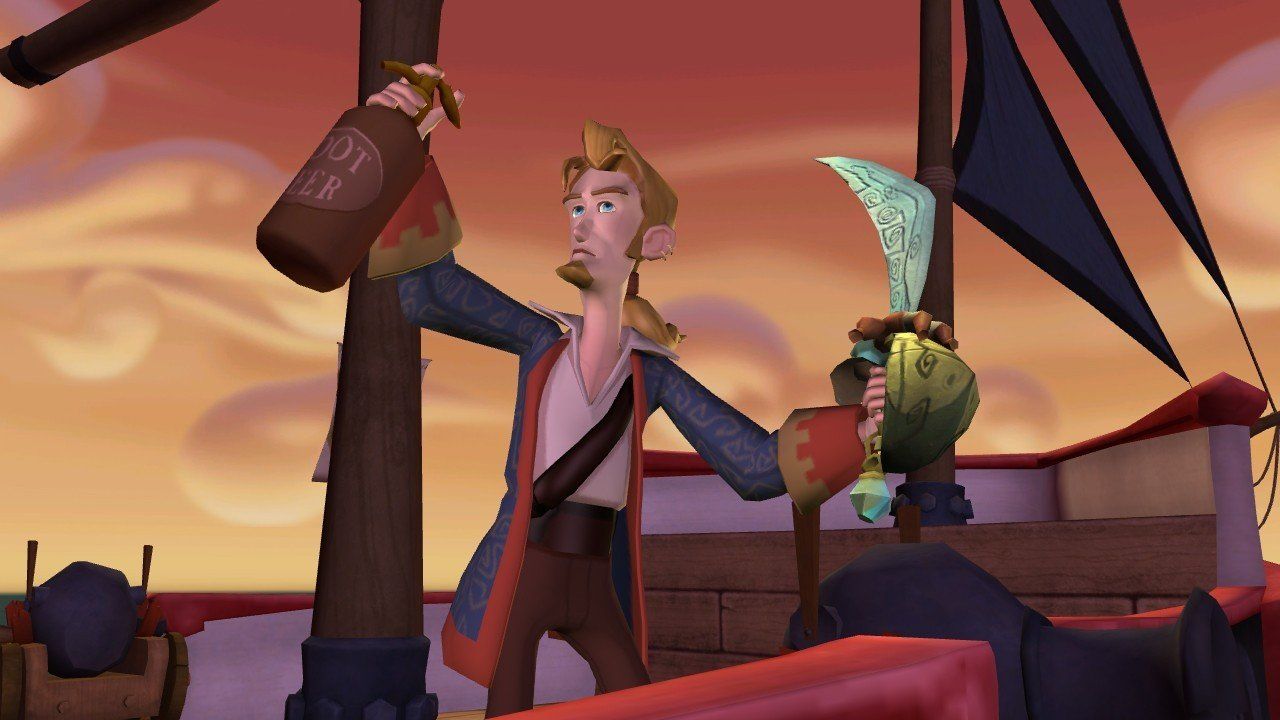
You know Threepwood, you’ve got spunk, pirate spunk
Tales of Monkey Island is split into five episodes, which fits quite well within Monkey Island’s usual structure, seeing the game split into several acts. Guybrush is once again his own second worst enemy, as he accidentally releases a voodoo pox while trying to defeat his number one worst enemy once and for all. Throughout the series, Guybrush will search for a giant sea sponge that can soak up the pox, get swallowed whole by a huge manatee, and scarier still, face consequences for his own actions. The increased focus on story and characters highlights what has always been Monkey Island’s strongest suit, but a portion of players who were more accustomed to LucasArts’ tricky puzzles were somewhat disappointed.
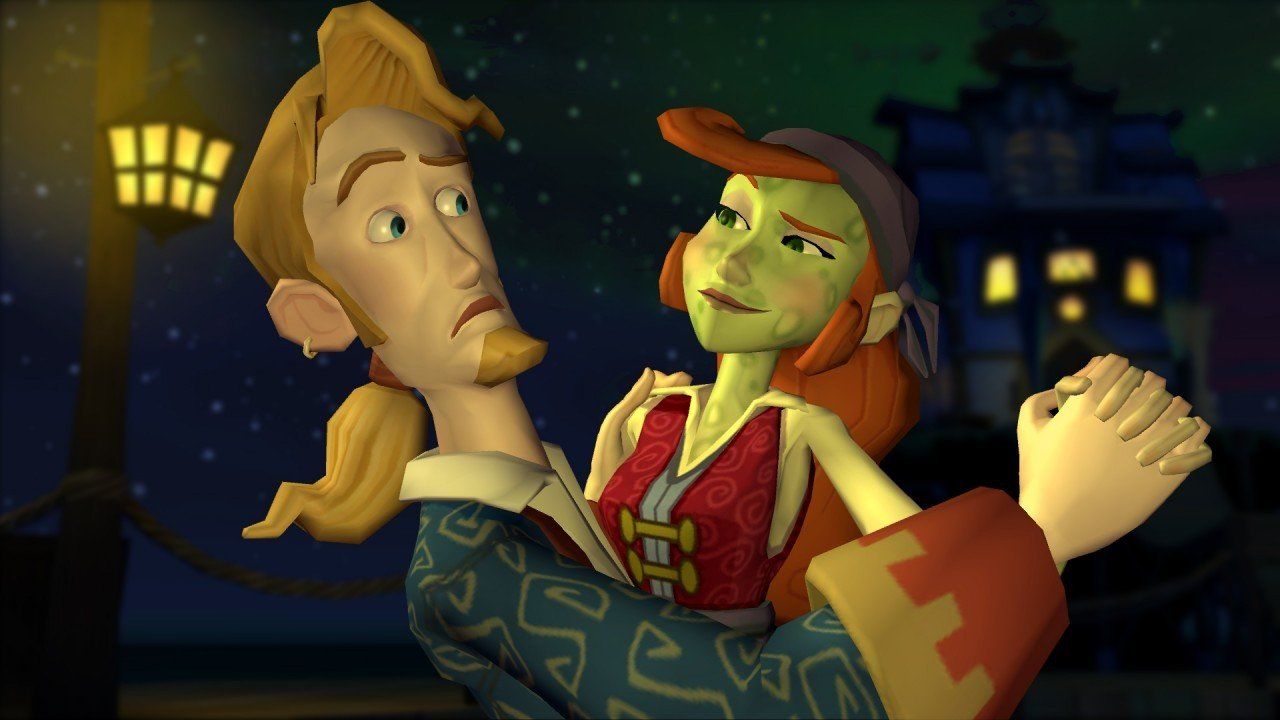
A messy end and an uncertain future
Telltale didn’t return to Monkey Island, and didn’t release a more traditional point and click adventure after 2010’s Sam and Max: The Devil’s Playhouse. They rode the success of The Walking Dead and expanded very quickly. Too quickly, it turned out, as Telltale abruptly shut down in 2018 after a major investor pulled funding. It was a sad end for a beloved studio, which was majorly mismanaged and developed awful working conditions.

While the rights for Monkey Island were in the air, the LucasArts-style point and click adventure was making a comeback of sorts (except in Germany, where they never stopped being popular), led by two of Monkey Island’s original creators. Tim Schafer’s Double Fine famously used Kickstarter to fund the adventure game Broken Age (2014), and a documentary following its development. They also bought the rights to Grim Fandango, Day of the Tentacle, and Full Throttle, remastering all of them. In 2017, Ron Gilbert’s new studio, Terrible Toybox, released Thimbleweed Park, an adventure game styled heavily on Maniac Mansion and The Secret of Monkey Island, right down to the verb list.

Look behind you, a new Monkey Island game!
On April Fool’s Day this year, Return to Monkey Island was announced, from Terrible Toybox and Devolver Digital, with David Grossman enlisted to help. It came way out of the blue, but was welcome news to fans. Opinion was divided on the art style, but reception for the game, which was released on September 19, has been very positive. It picks up after LeChuck’s Revenge, but doesn’t discount the games that came afterwards.
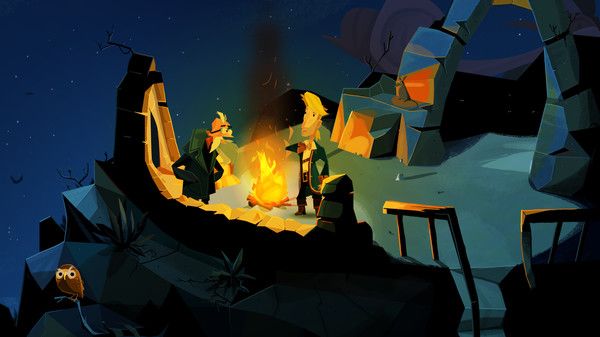
A legacy of laughs and fine leather jackets
If it hasn’t been made clear already, the Monkey Island series, and in particular the first two entries, have had a great influence on video games. This series not only brought the adventure game forward in leaps and bounds, it has remained a high watermark for video game writing and comedy. The humble point and click adventure has had its share of ups and downs, but The Secret of Monkey Island and LeChuck’s Revenge have remained a worthy part of the great gaming canon.